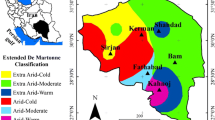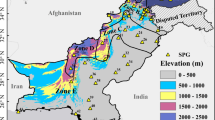Abstract
This paper reconsiders the precipitation concentration index (PCI) in Serbia using precipitation measurements such as the mean winter precipitation amount, annual total precipitation, mean summer precipitation amount, mean spring precipitation amount, mean autumn precipitation amount and the mean of precipitation for the vegetation period (April–September). Potentials for further improvement of PCI prediction lie in the improvement of current prediction strategies. One of the options is the introduction of model predictive control. To manage the PCI, it is good to select factors or parameters that are the most important for PCI estimation and prediction, i.e. to conduct variable selection procedure. In the present study, a regression based on the adaptive neuro-fuzzy inference system (ANFIS) is applied for selection of the most influential PCI inputs based on the precipitation measurements. The effectiveness of the proposed strategy is verified according to the simulation results. The results show that the mean autumn precipitation amount is the most influential for PCI prediction and estimation and could be used for the simplification of predictive methods to avoid multiple input variables.





Similar content being viewed by others
References
Aldair AA, Wang WJ (2011) Design an intelligent controller for full vehicle nonlinear active suspension systems. Int J Smart Sens Intell Syst 4(2):224–243
Alijani B, O’Brien J, Yarnal B (2008) Spatial analysis of precipitation intensity and concentration in Iran. Theor Appl Climatol 94(1):107–124
Anderson FO, Åberg M, Jacobsson SP (2000) Algorithmic approaches for studies of variable influence, contribution and selection in neural networks. Chemom Intell Lab Syst 51(1):61–72
Apaydin H, Erpul G, Bayramin I, Gabriels D (2006) Evaluation of indices for characterizing the distribution and concentration of precipitation: a case for the region of Southeastern Anatolia Project, Turkey. J Hydrol 328:726–732
Babovic V, Keijzer M (2000) Rainfall runoff modeling based on genetic programming. Nord Hydrol 33:331–346
Bacanli UG, Firat M, Dikbas F (2009) Adaptive neuro-fuzzy inference system for drought forecasting. Stoch Env Res Risk A 23:1143–1154
Bae D-H, Jeong DM, Kim G (2007) Monthly dam inflow forecasts using weather forecasting information and neuro-fuzzy technique. Hydrol Sci J 52:99–113
Castellano G, Fanelli AM (2000) Variable selection using neural-network models. Neurocomputing 31:1–13
Chang F-J, Chang Y-T (2006) Adaptive neuro-fuzzy inference system for prediction of water level in reservoir. Adv Water Resour 29:1–10
Chang F-J, Chiang Y-M, Tsai M-C, Hsu K-L, Sorooshian S (2014) Watershed rainfall forecasting using neuro-fuzzy networks with the assimilation of multi-sensor information. J Hydrol 508:374–384
Cibas T, Soulie FF, Gallinari P, Raudys S (1996) Variable selection with neural networks. Neurocomputing 12:223–248
Coscarelli R, Caloiero T (2012) Analysis of daily and monthly rainfall concentration in Southern Italy. J Hydrol 416–417:145–156
Crone SF, Kourentzes N (2010) Feature selection for time series prediction—a combined filter and wrapper approach for neural networks. Neurocomputing 73(10):1923–1936
Dastranj MR, Ebroahimi E, Changizi N, Sameni E (2011) Control DC motorspeed with adaptive neuro-fuzzy control (ANFIS). Aust J Basic Appl Sci 5(10):1499–1504
De Luis M, Reventos J, Gonzalez-Hidalgo JC, Sanchez IR, Cortina J (2000) Spatial analysis of rainfall trends in the region of Valencia (East Spain). Int J Climatol 20:1451–1469
De Luis M, Gonzalez-Hidalgo CJ, Brunetti M, Longares LA (2011) Precipitation concentration changes in Spain 1946–2005. Nat Hazards Earth Syst Sci 11:1259–1265
Dieterle F, Busche S, Gauglitz G (2003) Growing neural networks for a multivariate calibration and variable selection of time-resolved measurements. Anal Chim Acta 490(1–2):71–83
Eldessouki M, Hassan M (2015) Adaptive neuro-fuzzy system for quantitative evaluation of woven fabrics’ pilling resistance. Expert Syst Appl 42(4):2098–2113
El-Shafie A, Taha MR, Noureldin A (2007) A neuro-fuzzy model for inflow forecasting of the Nile River at Aswan High Dam. Water Resour Manag 21:533–556
Elshorbagy A, Corzo G, Srinivasulu S, Solomatine DP (2010) Experimental investigation of the predictive capabilities of data driven modeling techniques in hydrology—part 1: concepts and methodology. Hydrol Earth Syst Sci 14:1931–1941
Firat M, Güngör M (2010) Monthly total sediment forecasting using adaptive neuro fuzzy inference system. Stoch Env Res Risk A 24(2):259–270
Gocic M, Trajkovic S (2014a) Spatiotemporal characteristics of drought in Serbia. J Hydrol 510:110–123
Gocic M, Trajkovic S (2014b) Spatio-temporal patterns of precipitation in Serbia. Theor Appl Climatol 117(3–4):419–431
He Y, Tian P, Mu X, Gao P, Zhao G, Wang F, Li P (2016) Changes in daily and monthly rainfall in the Middle Yellow River, China. Theor Appl Climatol. doi:10.1007/s00704-016-1763-4
Huang J, Sun SL, Zhang JC (2013) Detection of trends in precipitation during 1960–2008 in Jiangxi province, southeast China. Theor Appl Climatol 14:237–251
Huang J, Liu F, Xue Y, Sun S (2015) The spatial and temporal analysis of precipitation concentration and dry spell in Qinghai, northwest China. Stoch Env Res Risk A 29(5):1403–1411
Islam T, Srivastava PK, Rico-Ramirez MA, Dai Q, Han D, Gupta M (2014) An exploratory investigation of an adaptive neuro fuzzy inference system (ANFIS) for estimating hydrometeors from TRMM/TMI in synergy with TRMM/PR. Atmos Res 145–146:57–68
Jang J-SR (1993) ANFIS: adaptive-network-based fuzzy inference systems. IEEE Trans On Syst Man Cybern 23:665–685
Jang J-SR, Sun C-T, Mizutani E (1997) Neurofuzzy and soft computing: a computational approach to learning and machine intelligence. Prentice-Hall, Upper Saddle River
John GH, Kohavi R, Pfleger K (1994) Irrelevant features and the subset selection problem. In: Machine Learning: Proceedings of the Eleventh International Conference, pp 121–129
Karimi-Googhari SH, Lee TS (2011) Applicability of adaptive neuro-fuzzy inference systems in daily reservoir inflow forecasting. Int J Soft Comput 6:75–84
Keskin ME, Taylan D, Terzi O (2006) Adaptive neural-based fuzzy inference system (ANFIS) approach for modelling hydrological time series. Hydrol Sci J 51:588–598
Kisi O, Haktanir T, Ardiclioglu M, Ozturk O, Yalcin E, Uludag S (2009) Adaptive neuro-fuzzy computing technique for suspended sediment estimation. Adv Eng Softw 40(6):438–444
Kodogiannis VS, Alshejari A (2014) An adaptive neuro-fuzzy identification model for the detection of meat spoilage. Appl Soft Comput 23:483–497
Koza JR (1992) Genetic programming: on the programming of computers by natural selection. MIT Press, Cambridge
La Rocca M, Perna C (2005) Variable selection in neural network regression models with dependent data: a subsampling approach. Comput Stat Data Anal 48(2):415–429
Li X, Jiang F, Li L, Wang G (2011) Spatial and temporal variability of precipitation concentration index, concentration degree and concentration period in Xinjiang, China. Int J Climatol 31(11):1679–1693
Lohani AK, Kumar R, Singh RD (2012) Hydrological time series modelling: a comparison between adaptive neuro-fuzzy, neural network and autoregressive techniques. J Hydrol 442–443:23–35
Longobardi A, Buttafuoco G, Caloiero T, Coscarelli R (2016) Spatial and temporal distribution of precipitation in a Mediterranean area (southern Italy). Environ Earth Sci 75:189. doi:10.1007/s12665-015-5045-8
Martins DS, Raziei T, Paulo AA, Pereira LS (2012) Spatial and temporal variability of precipitation and drought in Portugal. Nat Hazards Earth Syst Sci 12:1493–1501
Martin-Vide J (2004) Spatial distribution of a daily precipitation concentration index in peninsular Spain. Int J Climatol 24(8):959–971
Michiels P, Gabriels D, Hartmann Ghent R (1992) Using the seasonal and temporal precipitation concentration index for characterizing the monthly rainfall distribution in Spain. Catena 19:43–58
Nayak PC, Sudheer KP, Rangan DM, Ramasastri KS (2004) A neuro-fuzzy computing technique for modeling hydrological time series. J Hydrol 291(1–2):52–66
Oliver JE (1980) Monthly precipitation distribution: a comparative index. Prof Geogr 32(3):300–309
Petković D, Ćojbašić Ž (2012) Adaptive neuro-fuzzy estimation of automatic nervous system parameters effect on heart rate variability. Neural Comput & Applic 21(8):2065–2070
Petković D, Ćojbašić Ž, Lukić S (2013) Adaptive neuro fuzzy selection of heart rate variability parameters affected by autonomic nervous system. Expert Syst Appl 40(11):4490–4495
Raziei T, Bordi I, Pereira LS (2008) A precipitation-based regionalization for Western Iran and regional drought variability. Hydrol Earth Syst Sci 12:1309–1321
Scholz G, Quinton JN, Strauss P (2008) Soil erosion from sugar beet in Central Europe in response to climate change induced seasonal precipitation variations. Catena 72:91–105
Shi W, Yu X, Liao W, Wang Y, Jia B (2013) Spatial and temporal variability of daily precipitation concentration in the Lancang River basin, China. J Hydrol 495:197–207
Shi P, Qiao X, Chen X, Zhou M, Qu S, Ma X, Zhang Z (2014) Spatial distribution and temporal trends in daily and monthly precipitation concentration indices in the upper reaches of the Huai River, China. Stoch Env Res Risk A 28(2):201–212
Shojaei MJ, Bahrami E, Barati P, Riahi S (2014) Adaptive neuro-fuzzy approach for reservoir oil bubble point pressure estimation. J Nat Gas Sci Eng 20:214–220
Subbaraj P, Kannapiran B (2014) Fault detection and diagnosis of pneumatic valve using adaptive neuro-fuzzy inference system approach. Appl Soft Comput 19:362–371
Talei A, Chua LHC, Wong T (2010) Evaluation of rainfall and discharge inputs used by adaptive network-based fuzzy inference systems (ANFIS) in rainfall–runoff modeling. J Hydrol 391:248–262
Task Committee ASCE (2000a) Artificial neural networks in hydrology—1: preliminary concepts. J Hydrol Eng 5(2):115–123
Task Committee ASCE (2000b) Artificial neural networks in hydrology—2: hydrologic applications. J Hydrol Eng 5(2):124–137
Tsai M-J, Abrahart RJ, Mount NJ, Chang F-J (2014) Including spatial distribution in a data-driven rainfall-runoff model to improve reservoir inflow forecasting in Taiwan. Hydrol Process 28(3):1055–1070
Wahida Banu RSD, Shakila Banu A, Manoj D (2011) Identification and control of nonlinear systems using soft computing techniques. Int J Mod Optimization 1(1):24–28
Wang X, Han M (2015) Improved extreme learning machine for multivariate time series online sequential prediction. Eng Appl Artif Intell 40:28–36
Yang X-S (2009) Firefly algorithms for multimodal optimization. Stochastic algorithms: foundations and applications. Lect Notes Comput Sci 5792:169–178
Yang L, Entchev E (2014) Performance prediction of a hybrid microgeneration system using adaptive neuro-fuzzy inference system (ANFIS) technique. Appl Energy 134:197–203
Yeşilırmak E, Atatanır L (2016) Spatiotemporal variability of precipitation concentration in western Turkey. Nat Hazards 81(1):687–704
Zhang R, Wang W (2011) Facilitating the applications of support vector machine by using a new kernel. J Nat Gas Sci Eng 38(11):14225–14230
Zhang Q, Xu CY, Gemmer M, Chen YD, Liu C (2009) Changing properties of precipitation concentration in the Pearl River basin, China. Stoch Env Res Risk A 23(3):377–385
Zhang Q, Sun P, Singh VP, Chen X (2012) Spatial–temporal precipitation changes (1956–2000) and their implications for agriculture in China. Glob Planet Chang 82–83:86–95
Acknowledgements
The authors express their sincere thanks for the funding support to the Ministry of Education, Science and Technological Development, Republic of Serbia (grant no. TR37003) and the ICT COST Action IC1408 Computationally intensive methods for the robust analysis of non-standard data (CRoNoS).
Author information
Authors and Affiliations
Corresponding author
Rights and permissions
About this article
Cite this article
Petković, D., Gocic, M., Trajkovic, S. et al. Precipitation concentration index management by adaptive neuro-fuzzy methodology. Climatic Change 141, 655–669 (2017). https://doi.org/10.1007/s10584-017-1907-2
Received:
Accepted:
Published:
Issue Date:
DOI: https://doi.org/10.1007/s10584-017-1907-2




